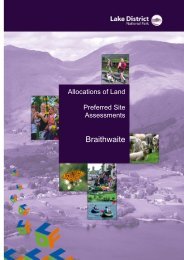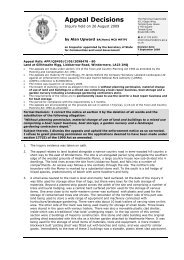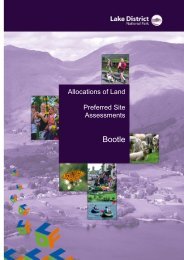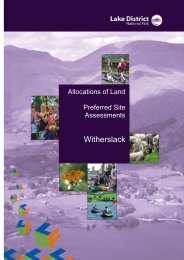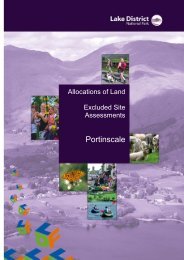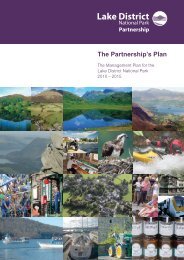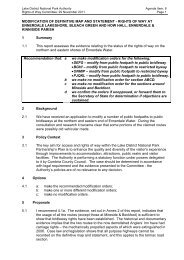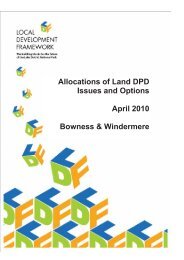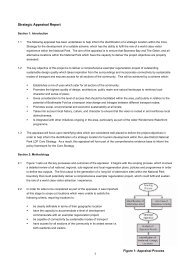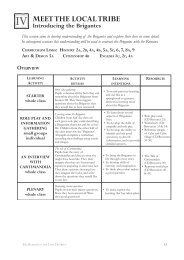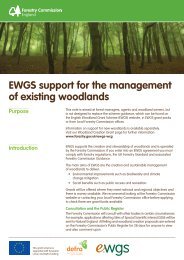Forest Carbon Account presentation (PDF) - Lake District National ...
Forest Carbon Account presentation (PDF) - Lake District National ...
Forest Carbon Account presentation (PDF) - Lake District National ...
Create successful ePaper yourself
Turn your PDF publications into a flip-book with our unique Google optimized e-Paper software.
Woodlands and <strong>Carbon</strong> in the<br />
<strong>Lake</strong> <strong>District</strong> <strong>National</strong> Park<br />
Presentation by Sandy Greig<br />
27 September 2012
Outline<br />
• Woodland resource in the LDNP<br />
• <strong>Carbon</strong> storage in LDNP woodlands<br />
• <strong>Carbon</strong> sequestration in LDNP woodlands<br />
• <strong>Carbon</strong> Gains – wood products and substitution<br />
• Woodland creation and carbon<br />
• So what: the wider context
Woodland Resource in the LDNP<br />
• Woodlands – NIWT 1999 – 28,412 hectares<br />
• 40% conifer<br />
• 42% broadleaf<br />
• 8% mixed<br />
• 0.3% coppice<br />
• 2.3% felled/windblow<br />
• 7.6% open space<br />
• 33% managed by FE
<strong>Carbon</strong> Storage in LDNP High <strong>Forest</strong><br />
Conifers: 5.2 million tonnes of CO2<br />
(410 tonnes per hectare)<br />
Broadleaves: 7.4 million tonnes of CO2<br />
(569 tonnes per hectare)<br />
Total: 12.6 million tonnes of CO2
000 tonnes CO2<br />
Chart 1: <strong>Carbon</strong> stored in tree biomass shown by species group<br />
4000<br />
3500<br />
3000<br />
2500<br />
2000<br />
1500<br />
1000<br />
500<br />
0<br />
Spruce Larch Other cons Ash/syc/bi Oak Other bdls
000 tonnes CO2<br />
Chart 2: <strong>Carbon</strong> stored in tree biomass shown by planting year class<br />
4000<br />
3500<br />
3000<br />
Broadleaves<br />
Conifers<br />
2500<br />
2000<br />
1500<br />
1000<br />
500<br />
0<br />
91-99 81-90 71-80 61-70 51-60 41-50 31-40 21-30 Pre 1921
<strong>Carbon</strong> Sequestration in LDNP High <strong>Forest</strong><br />
Conifers: 103,740 tonnes CO2 per annum<br />
(8.2 tonnes/ha/annum)<br />
Broadleaves: 55,860 tonnes CO2 per annum<br />
(4.3 tonnes/ha/annum)<br />
Total: 159,600 tonnes CO2 per annum
Net <strong>Carbon</strong> Sequestration in LDNP Woodlands<br />
• Conifers: 46,480 tonnes CO2 per annum<br />
(3.7 tonnes CO2/ha/annum)<br />
• Broadleaves: 51,020 tonnes CO2 per annum<br />
(3.9 tonnes CO2/ha/annum)<br />
Total: 97,500 tonnes CO2 per annum
<strong>Carbon</strong> Stores, Emissions and Gains<br />
• <strong>Carbon</strong> Stores:<br />
1. Above ground biomass<br />
2. Below ground biomass<br />
3. Wood products<br />
4. Change in soil carbon store<br />
• <strong>Carbon</strong> Emissions<br />
1. <strong>Forest</strong> management and harvesting<br />
2. Timber transport<br />
3. Product manufacture<br />
• <strong>Carbon</strong> Gains/Losses<br />
1. Direct substitution – woodfuel<br />
2. Material substitution<br />
3. Net carbon balance from land use change
Item<br />
Summary <strong>Carbon</strong> <strong>Account</strong> for LDNP woodlands<br />
Conifers<br />
(tCO2)<br />
Broadleaves<br />
(tCO2)<br />
Total<br />
(tCO2)<br />
Annual sequestration in tree biomass 103,460 56,140 159,600<br />
Removed in harvesting 57,260 4,840 62,100<br />
Net annual sequestration 46,200 51,300 97,500<br />
Added to wood product C store 34,190 1,400 35,590<br />
Material substitution C gain 20,900 600 21,500<br />
Woodfuel C gain 9,350 2,210 11,560<br />
Operational emissions 1,360 50 1,410<br />
Total net C gain 109,280 55,460 164,740<br />
Net C gain per ha 8.7 4.2 6.4
Tonnes CO2/ha<br />
<strong>Carbon</strong> Chart for LDNP Native Woodland Model: 100 Years<br />
500<br />
450<br />
400<br />
350<br />
300<br />
250<br />
200<br />
Woodfuel <strong>Carbon</strong> Gain<br />
Material Sub. <strong>Carbon</strong> Gain<br />
Wood Products <strong>Carbon</strong> Store<br />
Tree Biomass <strong>Carbon</strong> Store<br />
#REF!<br />
150<br />
100<br />
50<br />
0<br />
Years 0-100
Tonnes CO2/ha<br />
<strong>Carbon</strong> Chart for LDNP Conifer Model: 100 Years<br />
1000<br />
900<br />
800<br />
700<br />
600<br />
500<br />
400<br />
Woodfuel <strong>Carbon</strong> Gain<br />
Material Sub. <strong>Carbon</strong> Gain<br />
Wood Products <strong>Carbon</strong> Store<br />
#REF!<br />
Tree Biomass <strong>Carbon</strong> Store<br />
300<br />
200<br />
100<br />
0<br />
Years 0-100
So What?<br />
• <strong>Lake</strong> <strong>District</strong> currently responsible for GHG emissions of 2.3<br />
million tonnes CO2 per annum<br />
• Target to reduce this by 1% (i.e. 23,000 tonnes) per annum<br />
• A 1% improvement in the carbon performance of existing<br />
LDNP woodlands would contribute 7% towards the target<br />
• A mixed woodland planting programme of 350 hectares per<br />
annum would contribute 10% towards the target



